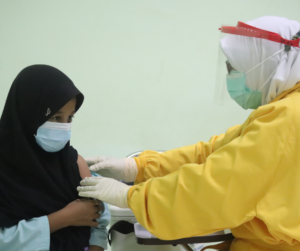Kristin Horwood ACNP-BC, AOCNP, MSN
VEXAS Syndrome Overview
VEXAS syndrome is a unique adult-onset disease with several varying clinical signs and symptoms. It is important for hematology/oncology advanced practice providers (APPs) to be aware of VEXAS syndrome as it is associated with several hematological disorders. V (vacuoles), E (E1 enzyme), X (X-linked), A (autoinflammatory), S (somatic mutation in ubiquitin-like modifier-activating enzyme 1 [UBA1] gene)1 syndrome was only recently described in 2020 as a new category of hemato-inflammatory diseases. This occurs from myeloid-driven inflammation arising from somatic mutations of the stem cell; in this case, mutations of the UBA1 gene.2 The syndrome is characterized by severe autoinflammation, which commonly presents with vasculitis, skin rash, polychondritis, arthritis, pulmonary inflammation, and constitutional symptoms. In a case series of 9 men with VEXAS syndrome, 88% had refractory constitutional symptoms that began 4 years prior to diagnosis.3
The diagnosis of VEXAS syndrome includes evidence of systemic inflammation, bone marrow biopsy findings of vacuoles of the myeloid and erythroid precursors with or without evidence of hematological malignancy, and the presence of the UBA1 mutation.1 Hematologic manifestations of VEXAS syndrome include macrocytic anemia, lymphopenia, thrombocytopenia, myelodysplastic syndrome (MDS, 30%-50% of cases), and monoclonal gammopathy of undetermined significance (10% of cases).4 Of note, there is a high risk of thrombosis associated with VEXAS syndrome with a 40% incidence overall.4 The most common hematologic disease associated with VEXAS is MDS. The presence of the UBA1 mutation can occur with other common myeloid molecular mutations; some frequent mutations are DNA methyltransferase 3 alpha (DNMT3A), ten-eleven translocation 2 (TET2), and enhancer of zeste homolog 2 (EZH2).
APPs are often tasked with managing the hematologic manifestations of VEXAS syndrome as well as the inflammatory symptoms. This can be perplexing as there are no FDA-approved therapies or current treatment guidelines, and most of the literature is reduced to case reports in a small series of patients. As this syndrome is highly associated with systemic inflammation, corticosteroids have been the most common treatment. Corticosteroids have long-term side effects with associated morbidity and mortality. The goal of introducing other treatments has largely been to reduce or eliminate corticosteroids. Other treatments have included Janus kinase (JAK) inhibitors, azacitidine, as well as Interleukin-1 (IL-1) and interleukin-6 (IL-6) blockade.
Treatment
A systematic review of 116 patients noted 36 patients received azacitidine. At 12-months follow-up, 25% of patients achieved a complete response (CR) and 38.9% a partial response (PR), while corticosteroids were reduced by 40%.5 In a case series of 3 patients who received azacitidine, two thirds of patients achieved a CR with suppression of the UBA1 clone.6 Of note, both patients who achieved this response also had a DNMT3A mutation. 6
In a multicenter retrospective study, JAK inhibitors achieved an overall response of 50% after 4 weeks of treatment.7 A subgroup analysis noted ruxolitinib was superior in achieving transfusion independence. The mutation allele burden of UBA1 was measured in 2 patients on ruxolitinib included in the analysis, and clonal expansion occurred in both patients.7
Treatment with IL-1 and IL-6 blockade was also included in the systematic review. Overall, there was a 66% reduction in steroids among those treated with IL-1 blockade.5
Allogeneic stem cell transplant (ASCT) serves as the only curative option for VEXAS syndrome. In the systematic review, 7 patients went on to ASCT. Median duration of follow-up was 5 months, 86% of patients achieved a CR.5
Considerations for APPs
While managing the treatment of patients with VEXAS syndrome, APPs need to consider prophylaxis and supportive care. For patients with neutropenia or lymphopenia, APPs may need to recommend antibacterial and/or antiviral prophylaxis. When prescribing JAK inhibitors, consider the thrombotic risk of VEXAS syndrome as well as that of JAK inhibitors. It is recommended that anticoagulation be considered for venous thromboembolism prophylaxis with careful attention to those that are thrombocytopenic. Patients who are anemic may require blood transfusions and/or erythropoiesis-stimulating agents to support red blood cells. 4
Discussion
VEXAS syndrome is a newly described inflammatory disorder that can occur with hematological malignancies. Management can be challenging for APPs due to lack of knowledge and current research to support treatment recommendations. Several studies published are retrospective case reviews and are reported on very small populations.
To date, ASCT is the only curative treatment option for patients; however, it can be a predicament to determine optimal timing for this. Azacitidine has had some promising results in a small case series of patients with resolution of the UBA1 clone and a durable response maintained for greater than 3 years in one patient. There is a need for prospective trials in larger patient cohorts to determine if these results are reproducible. JAK inhibitors are very effective at controlling inflammation and inducing clinical responses in patients; however, the responses have been short in duration. Furthermore, there was clonal expansion of the UBA1 clone observed in patients on ruxolitinib, which suggests that while symptoms are improved, the disease may be progressing. Future research is strongly required in this population and combination therapy with JAK inhibitors could be considered.
Recognition of progressing inflammatory symptoms in patients with certain hematological malignancies should prompt APPs to evaluate for VEXAS syndrome. Treatment goals for VEXAS syndrome should include reduction of corticosteroids, improvement of inflammatory symptoms, treatment of associated hematological malignancy, and molecular response with reduction of UBA1 clone.

Kristin Horwood ACNP-BC, AOCNP, MSN, RN, is a nurse practitioner at University of Southern California. She has expertise in the diagnosis and treatment of myeloproliferative neoplasms, myelodysplastic syndrome, multiple myeloma, and rare blood disorders.
References
- eck, D. B., Ferrada, M. A., Sikora, K. A., Ombrello, A. K., Collins, J. C., Pei, W., Balanda, N., Ross, D. L., Ospina Cardona, D., Wu, Z., Patel, B., Manthiram, K., Groarke, E. M., Gutierrez-Rodrigues, F., Hoffmann, P., Rosenzweig, S., Nakabo, S., Dillon, L. W., Hourigan, C. S., Tsai, W. L., … Grayson, P. C. (2020). Somatic Mutations in UBA1and Severe Adult-Onset Autoinflammatory Disease. The New England journal of medicine, 383(27), 2628–2638. https://doi.org/10.1056/NEJMoa2026834
- Al-Hakim, A., & Savic, S. (2023). An update on VEXAS syndrome. Expert review of clinical immunology, 19(2), 203–215. https://doi.org/10.1080/1744666X.2023.2157262
- Koster, M. J., Kourelis, T., Reichard, K. K., Kermani, T. A., Beck, D. B., Cardona, D. O., Samec, M. J., Mangaonkar, A. A., Begna, K. H., Hook, C. C., Oliveira, J. L., Nasr, S. H., Tiong, B. K., Patnaik, M. M., Burke, M. M., Michet, C. J., Jr, & Warrington, K. J. (2021). Clinical Heterogeneity of the VEXAS Syndrome: A Case Series. Mayo Clinic proceedings, 96(10), 2653–2659. https://doi.org/10.1016/j.mayocp.2021.06.006
- Zhang, Y., Dong, X., & Wang, H. (2023). VEXAS Syndrome-Review. Global medical genetics, 10(3), 133–143. https://doi.org/10.1055/s-0043-1770958
- Boyadzhieva, Z., Ruffer, N., Kötter, I., & Krusche, M. (2023). How to treat VEXAS syndrome: a systematic review on effectiveness and safety of current treatment strategies. Rheumatology (Oxford, England), 62(11), 3518–3525. https://doi.org/10.1093/rheumatology/kead240
- Heiblig, M., Ferrada, M. A., Koster, M. J., Barba, T., Gerfaud-Valentin, M., Mékinian, A., Coelho, H., Fossard, G., Barraco, F., Galicier, L., Bienvenu, B., Hirsch, P., Vial, G., Boutin, A. B., Galland, J., Le Guenno, G., Bigot, A., Warrington, K. J., Kermani, T. A., Grayson, P. C., … Sujobert, P. (2022). Ruxolitinib is more effective than other JAK inhibitors to treat VEXAS syndrome: a retrospective multicenter study. Blood, 140(8), 927–931. https://doi.org/10.1182/blood.2022016642







